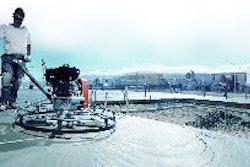
The U.S. Environmental Protection Agency's storm-water runoff rules for construction sites will apply to road expansion projects. Contractors working on highway projects long have been required to control runoff, but the EPA rules released this month require water flowing from construction sites to meet strict water-quality standards.
Nick Goldstein, assistant general counsel and director of regulatory affairs for the American Road & Transportation Builders Association, questioned whether the new rules are even necessary on road projects.
Runoff from a highway expansion causes less damage than runoff from a vertical construction site, he said.
Highway runoff is less concentrated because it is spread over whatcan be miles of roadway, Goldstein said.
Starting in 2011, the runoff rules will apply to all projects thatdisturb 20 acres or more. In 2014, the EPA rules will regulate all projects that disturb 10 acres or more.
A highway job can cause as much damage as a vertical construction site, especially if the work is around a bridge over water, said Bob Newport, storm-water specialist in the EPA's Chicago regional office,which oversees Wisconsin. State transportation departments already require contractors take steps to control storm water, he said.
Roads have been in and under this program already, he said.
The Wisconsin Department of Transportation, through an agreement with the state Department of Natural Resources, requires runoff controls on projects.
But unlike the WisDOT-DNR agreement, the EPA requires water quality be measured in nephelometric turbidity units. The higher the NTU, the more dirt or sediment in the water. The EPA rule sets the limit at280 NTU.
But, by setting a numeric limit on runoff water quality, the new EPA rules may require more expensive storm-water control methods than the retention ponds and bio-swales commonly in use, Goldstein said.
This is especially likely in states, such as those in the Northwest, that get high levels of precipitation, he said. Wisconsin, he said, is not one of those states.
To try to tell them all that they have to adhere to the same numeric standard is counterproductive, he said, because the EPA rules could undermine finely tuned standards departments of transportation already have established.
In many cases, the runoff control methods that states already require will be enough to satisfy the EPA's numeric threshold, Newport said.
There is going to be a lot of projects where the design that they would be using right now would probably meet the effluent guidelines,Newport said.
Goldstein said that's a reach.
I think it's tough to say that, he said. And if that's the case, why do you need the numeric standards there in the first place?
The EPA set a specific number because regulators need a way to determine whether required practices are working, Newport said.
Our rule, he said, it just sort of further clarifies the minimum standard of what we expect to see.


















